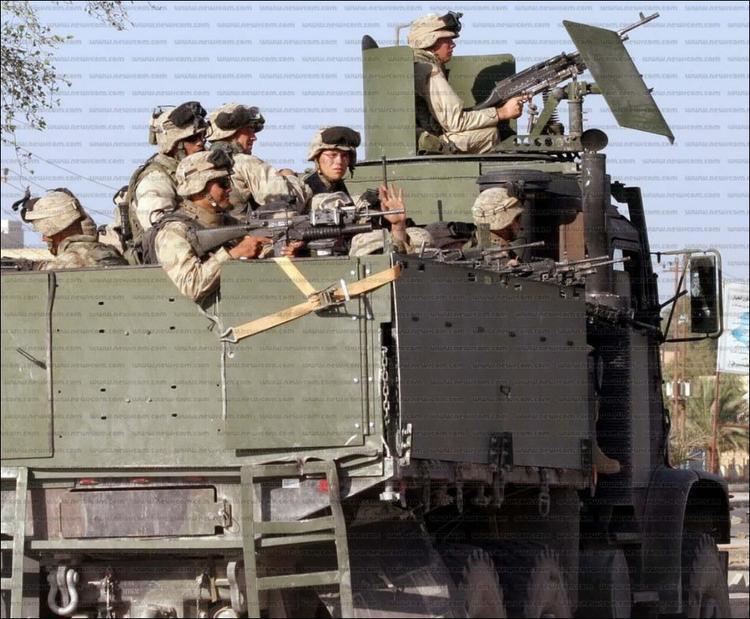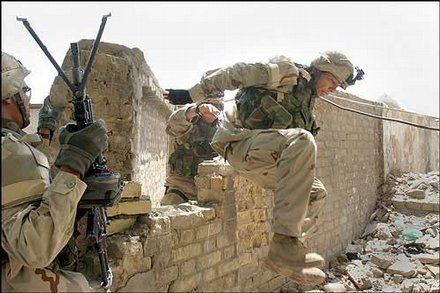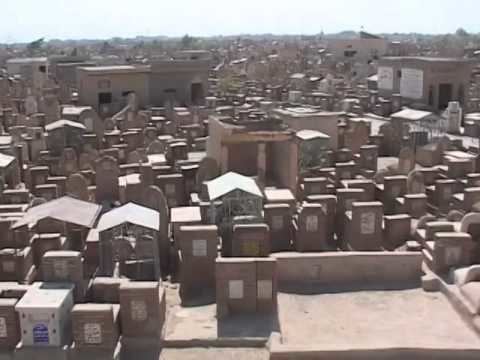Dates 5 Aug 2004 – 27 Aug 2004 | ||
2,000 U.S.1,800 Iraqi Security Forces Estimates range from 14,000 to 15,000 13 killed, 100+ wounded, 2 tanks, 4 armored vehicles destroyed (U.S.)40 killed, 18 captured,46 wounded (Iraqi Security Forces) 1,594 killed, 261 captured Similar Iraq War, Battle of Umm Qasr, Battle of the Karbala Gap, Battle of Samawah, Operation Augurs of Prosperity | ||
The Battle of Najaf was fought between United States and Iraqi forces on one side and the Islamist Mahdi Army of Muqtada al-Sadr on the other in the Iraqi city of Najaf in August 2004.
Contents
Background

On 31 July 2004 the 11th Marine Expeditionary Unit, under the Polish-led Multinational Division Central-South (MND-CS), assumed operational control of An Najaf and Al-Qadisiyyah provinces from Task Force Dragon, which was composed of elements of the 1st Infantry Division. Task Force Dragon had earlier (June 2004) relieved the 2nd Armored Cavalry Regiment who had been extended twice in Iraq.

The MEU and the Mahdi Army first exchanged fire on 2 August, when a patrol by Combined Anti-Armor Team (CAAT) Alpha Wpns Co 1st Battalion 4th Marines (1/4) approached a maternity clinic located directly across the street from the home of Muqtada al-Sadr on the outskirts of the city. The clinic was in an area authorized for U.S. presence under a June cease-fire agreement brokered between coalition forces and Muqtada Sadr by the Governor of Najaf, other local civic leaders, and the Bayt al-Shia (the informal council of senior Shia clerics). The Marines reported over 70 enemy dead after nearly an hour of fighting. The Mahdi Army kept a steady resupply of men and weapons coming out of the Wadi-us-Salaam cemetery. CAAT Alpha faced mortars, RPG's (Rocket Propelled Grenades) and small arms fire with one Marine wounded until running low on ammunition. 1/4's Bravo Co. was sent in on 7-ton trucks to provide covering fire for CAAT Alpha. Both sides withdrew to their respective strongholds soon afterwards.
Battle

Major conflict began on 5 August, when the Mahdi Army (MA) attacked an Iraqi Police Station at 1 am. Their first attack was repelled but the MA regrouped and attacked again at 3 am. Soon after, a quick reaction force (QRF) from the MEU was dispatched at the request of the governor of An Najaf. Around 11 am the QRF came under heavy machine gun and mortar fire from the Mahdi Army within the Wadi-us-Salaam, the largest cemetery in the Muslim world approximately 7 miles squared. The cemetery has been layered over the centuries resulting in large underground tombs, tunnels and surface monuments, many reaching two stories tall. The Soldiers of 1/5 Cav fought across this inhospitable terrain and under it in some of the first tunnel fighting seen since Vietnam.

A U.S. Marine UH-1N helicopter was shot down by small-arms fire on the second day of the fighting while conducting a close air support mission over enemy positions, the crew survived. Four U.S. military personnel were killed during the heavy street battles fought between the Mahdi Army and U.S. and Iraqi forces, until the MEU withdrew temporarily on 7 August. On 9 August the U.S. added three battalions from the U.S. Army to the battle:

During the fighting half a dozen U.S. Abrams tanks and Bradley fighting vehicles were damaged or disabled by insurgent RPG fire in the narrow streets.
Fighting began in the city centre and then moved through the cemetery. After several days the fighting shifted to the environs of the Imam Ali Mosque when the Mahdi Army withdrew and took refuge there. United States Army Soldiers from B Co. 1-5 Cav encircled the complex after fighting through the Old City and began a siege. The Mahdi Army utilized large hotels that overlook the cemetery as overwatch machine gun positions. A Bradley from 1-5 Cav shot TOW missiles at the Mahdi machine gun positions while Soldiers from Alpha and Bravo Co. 1-5 Cav assaulted several of these hotels. After heavy hand to hand and room to room fighting the hotels were secured, relieving elements of Charlie Co. who were pinned down in the cemetery. There were not enough soldiers however to properly hold the hotels and they were consolidated to two adjoining ones. The fighting damaged two of the minarets of the mosque, one of the holiest of all Shiite shrines. (Although neighboring buildings suffered considerable damage, the mosque itself suffered only superficial damage from stray bullets and shrapnel).
On 23 August at least 15 explosions, many sounding like artillery shells, rocked the area, as shrapnel fell in the courtyard of the gold-domed mosque and gunfire echoed through the alleyways. On 26 August 2004, two F-16s flying out of Balad dropped four 2000 pound JDAMs (Joint Direct Attack Munitions) on two hotels near the shrine which were being used by the insurgents. The successful airstrike dealt a devastating blow to Sadr and led to a hasty settlement with Grand Ayatollah Sistani the following morning allowed Al-Sadr and the remnants of his militia to leave Najaf. This arrangement was only favorable to the Americans because it relieved them of the need to enter the Imam Ali Mosque. The Infantryman of 1-5 Cav and Army armor crewmen lined the street watching Sadr's Mahdi Army leave the mosque.
Aftermath
The battle ended on 27 August 2004 with a negotiated ceasefire: Mahdi army fighters surrendered their weapons before leaving and none of them were detained; Marine battalion 1/4 and the Iraqi police took control of the security in the city. Sporadic fighting continued for some months. Some MA fighters from Najaf went to Sadr City in Baghdad, where there had also been heavy fighting, to help the Mahdi Army in their guerrilla activities against U.S and Iraqi forces. A final agreement between the U.S. and Muqtada al-Sadr was reached by the end of September and fighting ceased in early October. Fighting spread to Najaf province and lasted for several more months before finally winding down.
